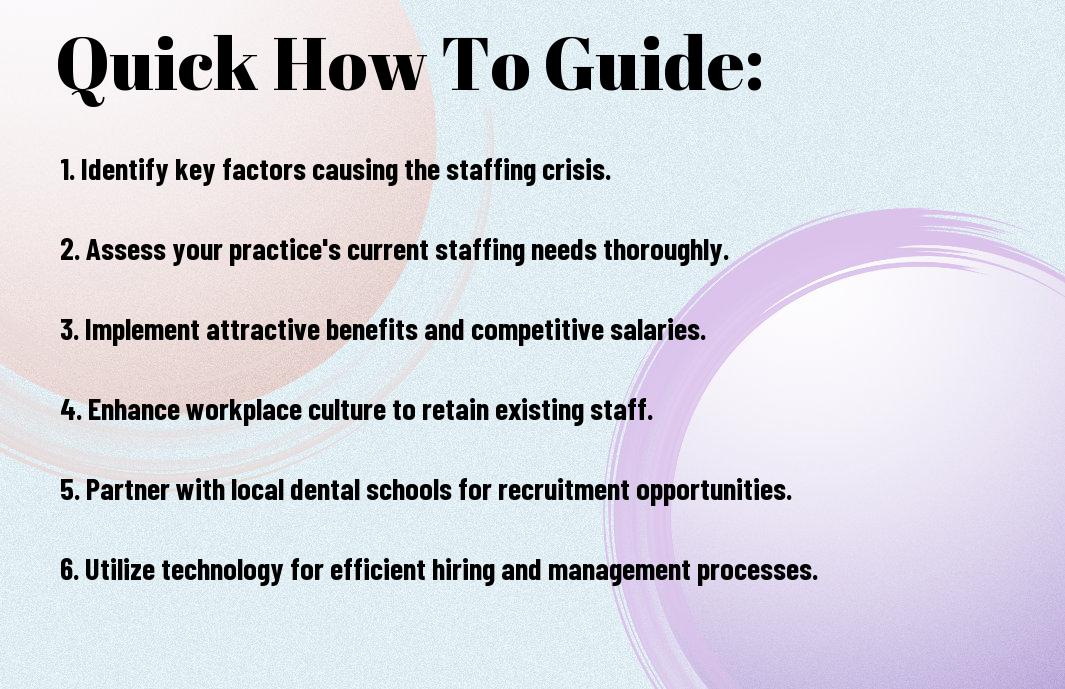The Dental Staffing Crisis – Why It’s Happening and How to Overcome It
Crisis situations in the dental industry can lead to significant disruptions. I find it crucial to understand the factors behind this staffing shortage, including increased demand for services and challenges in recruitment. In this post, I will examine into the reasons driving this crisis and equip you with effective strategies to overcome these challenges and build a stronger, more resilient dental team. Let’s explore how you can navigate this landscape successfully.
Key Takeaways:
- The dental staffing crisis is primarily driven by increasing demand for dental services coupled with a shortage of trained professionals in the field.
- Workforce burnout and job dissatisfaction due to high-pressure environments contribute significantly to the staffing shortages experienced in many dental practices.
- Enhanced recruitment strategies, including competitive salaries and improved work environments, are necessary for attracting new talent into the dental industry.
- Investing in ongoing professional development and creating career advancement opportunities can help retain existing staff and boost morale.
- Collaboration between dental schools, associations, and practices is vital to address workforce shortages and ensure a steady pipeline of new professionals entering the field.

Understanding the Dental Staffing Crisis
The dental staffing crisis presents a significant challenge for the industry, affecting both practices and patients. With an increasing demand for dental services and a shortage of qualified professionals, I see a growing gap between the number of positions available and the workforce needed to fill them. This situation necessitates a deeper understanding of the factors contributing to this crisis and the implications it has on patient care.
Current Statistics and Industry Trends
Assuming current trends continue, we can expect a dramatic increase in dental profession vacancies over the next few years. Reports indicate that up to 50% of dental practices are struggling to maintain adequate staffing levels, leading to longer wait times for patients and increased pressure on existing staff. These statistics highlight the urgency for immediate action and innovative solutions to attract and retain talent in the dental field.
Impact on Dental Practices and Patient Care
Dental practices are feeling the strain of the staffing crisis in multiple ways, leading to suboptimal patient care. To navigate this crisis, practices are often forced to operate with reduced staff. This staffing shortage affects not only the efficiency of service delivery but also the quality of care you receive. With fewer professionals available, patients face increased wait times and reduced interaction with dental teams, which can adversely impact their overall experience and outcome. Furthermore, overworked staff may lead to higher rates of burnout, further exacerbating the staffing issue.
Key Factors Contributing to the Staffing Shortage
Any examination of the dental staffing crisis must address significant factors influencing the current shortage. Among these are:
- Aging workforce transitioning into retirement
- Increased career changes influenced by the pandemic
- Challenges in dental education limiting new entrants
- Competitive compensation making recruitment difficult
Assume that addressing these underlying issues is crucial to navigating the future of dental staffing.
Retirement and Career Changes Post-Pandemic
Little did I know, the pandemic would accelerate retirement and career changes among dental professionals. Many dentists and hygienists, faced with such unprecedented challenges, opted to step back from their careers, contributing to an increasing void in experienced staff. The emotional toll and reevaluation of personal priorities during this time led to a wave of exits from the field.
Educational Pipeline Challenges
Educational institutions have grappled with post-pandemic obstacles, which have strained the dental workforce pipeline. Many graduates struggled to find placements due to a decline in acceptance rates at dental schools, and a lack of hands-on experience hampered their readiness for the workforce.
Post-pandemic, I have observed that the demand for dental professionals has surged, while the supply of new graduates has not kept pace. This disparity has resulted in significant challenges for dental practices looking to hire. Additionally, the educational curriculum has faced pressures to adapt to modern practices, yet many programs still lag behind. As a result, graduates may not possess the skills needed to succeed immediately, compounding the staffing crisis.
Competitive Compensation Issues
You might find yourself wondering why attracting qualified dental professionals has become increasingly difficult. A key issue is that many practices struggle to offer competitive compensation packages that meet the rising cost of living and student loan debt faced by new hires. Without attractive financial incentives, recruitment efforts are impeded.
A less competitive salary structure often leads to high turnover rates, which can prove detrimental to a practice’s stability. As demand for dental care continues to increase, many potential hires leave their positions for opportunities that provide better benefits and compensation. Therefore, fostering a positive work environment with adequate pay and benefits is vital for retaining skilled professionals and addressing the staffing crisis effectively.
How to Improve Recruitment Strategies
Now, improving your recruitment strategies is vital to overcoming the dental staffing crisis. You must approach recruitment with a fresh perspective, utilizing creative methods to attract talented professionals to your practice. By understanding what potential candidates value in a workplace, you can effectively tailor your strategies to meet their needs, making your dental office an appealing destination for skilled individuals.
Creating Compelling Job Descriptions
Creating a compelling job description is imperative for attracting the right candidates. Focus on highlighting not just the responsibilities, but also the culture of your practice and the benefits you offer. Make sure to articulate what sets your office apart, whether it be growth opportunities, work-life balance, or team dynamics. Engaging language can make a big difference in catching the attention of potential applicants.
Leveraging Digital Platforms and Professional Networks
With the ongoing advancements in technology, leveraging digital platforms and professional networks has become a game-changer in recruitment. It allows you to reach a broader audience and connect with potential candidates who are actively seeking opportunities in the dental field.
A powerful way to enhance your recruitment efforts is through social media and professional networking sites like LinkedIn. By posting job openings and updates about your practice, you can showcase your culture and values. Engaging with candidates through these channels gives them a glimpse into your office environment. Develop an online presence that is not only professional but also reflects your practice’s atmosphere. Using targeted advertising can further enhance your search for talent, allowing you to reach specific demographics that are most likely to resonate with your offerings. Building a strong network can lead to referrals and recommendations, effectively expanding your reach and attracting quality candidates who share your vision and values.
Retention Tips That Actually Work
Once again, the focus on retaining talented staff is key in overcoming the dental staffing crisis. Here are a few effective strategies:
- Foster open communication
- Offer continued education
- Recognize achievements
- Encourage work-life balance
This approach not only promotes loyalty but also enhances the overall office atmosphere.
Developing Competitive Compensation Packages
To attract and retain your dental professionals, you must create competitive compensation packages that reflect their skills and contributions. Consider not only salaries but also benefits such as health insurance, retirement plans, and bonuses for exceptional performance. By offering a comprehensive package, you send a clear message that their work is valued.
Creating a Positive Practice Culture
One of the most effective ways to improve retention is by fostering a positive practice culture. A culture where team members feel respected, appreciated, and engaged leads to better job satisfaction and less turnover.
Practice creating an environment that prioritizes team collaboration and open dialogue. You can host regular team-building activities and encourage feedback on practice operations. When your team members feel they have a voice and contribute to the workplace environment, their morale thrives. A positive culture not only leads to employee satisfaction but also impacts patient care and overall practice success. Invest in your team’s happiness; it will pay dividends in retention and performance.
Practical Solutions for Short-Staffed Practices
After examining the challenges of the dental staffing crisis, I believe it is vital to implement effective strategies to keep your practice running smoothly. By focusing on actionable solutions, I found the Dental Workforce Check-In: 10 Steps to Excellence … serves as a valuable resource to enhance your staffing approaches and reduce operational strain.
Streamlining Clinical Workflows
You need to simplify your clinical processes to optimize the time and energy of your remaining staff. By defining clear roles and responsibilities, you can eliminate unnecessary duplication of efforts. Implement regular team meetings to discuss workflows and streamline operations to enhance overall efficiency.
Technology Integration to Reduce Workload
Little adjustments in technology can significantly alleviate the daily burdens on your staff. Automating appointment reminders, managing patient records electronically, and using digital treatment planning software can provide your team with more time for patient care.
Solutions like digital solutions not only boost efficiency but also enhance the patient experience. By implementing tools like electronic health records and practice management software, you minimize the likelihood of errors and reduce administrative load. These technologies play a pivotal role in allowing remaining team members to focus on delivering exceptional patient care instead of getting caught up in paperwork. I encourage you to evaluate your practice’s current technology and consider how investing in these systems can lead to a more productive and positive work environment.

Building a Sustainable Staffing Model
Keep your dental practice strong by establishing a sustainable staffing model that prioritizes stability and adaptability. This involves regularly evaluating your team’s needs, fostering a positive workplace culture, and leveraging technology for efficient scheduling. By being proactive, you can reduce turnover rates and ensure your practice can consistently deliver high-quality care to your patients.
Investing in Training and Development
Clearly, investing in training and development is important for creating a knowledgeable and skilled workforce. By offering ongoing education, you not only enhance your team’s expertise but also demonstrate your commitment to their professional growth, leading to increased job satisfaction and retention.
Creating Career Advancement Pathways
Training opportunities should align with career advancement pathways that empower your staff to reach their full potential. This enables them to visualize a long-term commitment to your practice while enhancing their skills. A structured program where roles are clearly defined and progression steps are outlined can motivate employees, leading to higher engagement levels and a more robust workforce.
To effectively implement career advancement pathways, you need to engage in open discussions with your team about their goals and aspirations. This involves identifying key roles, establishing benchmarks for progression, and providing targeted training to facilitate growth. When your staff sees a clear route for advancement, they are more likely to commit to your practice long-term, ultimately leading to a more experienced and loyal team. Additionally, ensuring these pathways are communicated transparently will foster trust and a sense of belonging within your organization.
Conclusion
With this in mind, the dental staffing crisis presents challenges that require our immediate attention and innovative solutions. As I’ve explored, understanding the underlying factors, from workforce shortages to evolving practice demands, is important in overcoming these obstacles. You can take proactive steps to attract and retain talent, such as enhancing workplace culture and offering competitive benefits. By actively engaging in these strategies, you can position your practice for success and ensure that you have the skilled team necessary to provide exceptional patient care.
FAQ
Q: What is the dental staffing crisis?
A: The dental staffing crisis refers to the shortage of qualified dental professionals, including dentists, hygienists, and dental assistants, impacting the ability of dental practices to maintain operations and meet patient needs. This shortage is attributed to various factors, including workforce burnout, changing career preferences, and an increase in demand for dental services.
Q: What are the main causes of the dental staffing crisis?
A: Several factors contribute to the dental staffing crisis, such as the aging population requiring more dental care, increased job dissatisfaction among dental professionals, the effect of the COVID-19 pandemic on workforce dynamics, and a shortage of dental education programs that can adequately train new professionals.
Q: How has the COVID-19 pandemic impacted dental staffing?
A: The COVID-19 pandemic has significantly affected dental staffing by exacerbating existing shortages. Many dental professionals have left the field due to health concerns, burnout, or changes in career paths. Additionally, the economic uncertainty led to practice closures and job losses, further reducing the number of available dental staff.
Q: What strategies can dental practices implement to address staffing shortages?
A: Dental practices can consider various strategies to alleviate staffing shortages, including offering competitive salaries and benefits, providing flexible working conditions, investing in staff development and training, leveraging technology for efficiency, and collaborating with dental schools to create pipeline programs for future talent.
Q: Are there long-term solutions to the dental staffing crisis?
A: Long-term solutions involve creating a more sustainable dental workforce by increasing funding for dental education programs, revising licensure requirements to facilitate entry into the field, and addressing workplace culture to improve job satisfaction and retention among dental professionals.
Q: How can dental practices retain their current staff during a staffing crisis?
A: To retain staff, dental practices should focus on creating a positive work environment that prioritizes employee well-being. This may include regular feedback opportunities, recognizing staff contributions, ensuring manageable workloads, and offering professional development programs that enhance their skills and career growth.
Q: What role do dental schools play in mitigating the staffing crisis?
A: Dental schools play a significant role in mitigating the staffing crisis by producing qualified graduates ready to enter the workforce. By adjusting their curricula to address current industry needs, expanding enrollment, and providing internships and hands-on experiences, dental schools can help ensure a steady influx of new talent into the profession.


